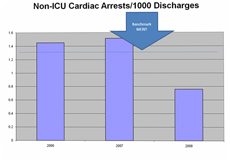Intensive Care Department

The Facility:
The Intensive Care Department is equipped with state of the art technologies. In addition, the new unit design does not only meet the international standards but also provides a better environment for the critically ill patients; with its large rooms, better views and improved privacy.
Medical Coverage:
Intensive Care Department at King Abdulaziz Medical City has a unique medical coverage by having on-site Consultant 24-hours a day / 7-days a week. This experience was recently published as a Feature Article in the Critical Care Medicine journal.
Several previous studies in which traditional coverage in which the Consultant is on-site only during business hours have shown increase in mortality during weekends and at nighttime. This recent study from King Abdulaziz Medical City demonstrated that with the 24-hour coverage, the outcomes are the same regardless of the times of admission. In an accompanying editorial, Dr. Afessa from Mayo Clinic College of Medicine recommended adopting the 24 hours / 7 days coverage “in order to provide the best care to critically ill patients”.
New Technologies:
High Frequency Oscillation Ventilation (HFOV):
HFO is a method of mechanical ventilation designed to deliver extremely small tidal volumes around a set mean airway pressure at high respiratory rates. HFO, widely and effectively used in neonates and children for many years, is only recently available for adult use. There is data to suggest that HFOV is advantageous to conventional ventilation in patients with severe ARDS in reducing ventilator-induced lung injury, an important contributor to the high mortality in ARDS. This technology was introduced to King Abdulaziz Medical City in 2007. KAMC-ICU has participated in a multicenter pilot randomized controlled trial comparing HFOV to conventional ventilation lead by Drs Maureen Meade (McMaster University) and Niall Ferguson (University of Toronto). KAMC-ICU is a co-applicant on the large definitive OSCILLATE trial.
Point of Care Critical Care Ultrasonography:
The physical exam and the traditional imaging pathways have limitations in the Intensive Care Department that point-of-care ultrasonography helps address. Compared to traditional ultrasound testing, there may be significant advantages to having focused ultrasound performed and read by the intensivists who know the patient's condition the best. Ultrasound performed by the bedside clinician may allow quicker, more direct answers to critical questions. This new imaging paradigm makes the process more efficient for the critically ill patients. This approach also makes performing serial exams more feasible (e.g., to assess for the response to hemodynamic intervention). In addition, when delays are prevented and procedures are ultrasound-guided, the delivery of care may become safer and more effective. The use of ultrasound for the placement of central venous catheters has been shown to significantly reduce complications and has become the standard of care for safe procedures. KAMC-ICU has adopted this approach in 2007 and is utilizing ultrasonography increasingly in the bedside evaluation of ICU patients.
Extracorporeal liver dialysis system:
This technology is has existed for approximately ten years. It consists of two separate dialysis circuits. The first circuit consists of human serum albumin, is in contact with the patient's blood through a semipermeable membrane and has two special filters to clean the albumin after it has absorbed toxins from the patient's blood. The second circuit consists of a hemodialysis machine and is used to clean the albumin in the first circuit, before it is recirculated to the semipermeable membrane in contact with the patient's blood. The system can remove a number of toxins, including ammonia, bile acids, bilirubin, copper, iron and phenols. The benefit of this technology has not been fully established but it might have role in selected patients. This technique was introduced in King Abdulaziz Medical City in 2008.